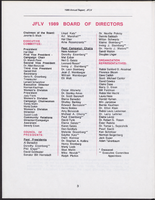Search the Special Collections and Archives Portal
Search Results
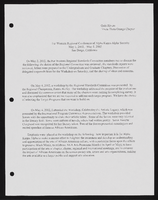
Alpha Kappa Alpha Sorority, Theta Theta Omega Chapter 73rd Far Western Regional conference agenda and report
Date
Archival Collection
Description
From the Alpha Kappa Alpha Sorority, Incorporated, Theta Theta Omega Chapter Records (MS-01014) -- Chapter records file.
Text
Southern Nevada Chapter of the American War Mothers Organization Records
Identifier
Abstract
The Southern Nevada Chapter of the American War Mothers Organization Records (1947-1995) are comprised primarily of scrapbooks containing correspondence and minutes, numerous newspaper clippings, and photographs. Also included are pamphlets on American War Mothers organizational rituals, bylaws, history, ceremonial ephemera, flags, and a Henderson Chapter Charter. The materials also contain items relating to the North Las Vegas Chapter, the Rose Garden Chapter, and the State Chapter.
Archival Collection
Charles P. Squires Photograph Collection
Identifier
Abstract
The Squires Family Photographs document the Squires Family and the development of the Las Vegas Valley in Nevada from approximately 1860 to 1980, with a bulk of the photographs depicting people and events from 1900 to 1950. The photographs depict the Euro-American settlement and growth of Las Vegas, Nevada; traveling and exploration of Southern Nevada and the Southwestern United States; the Hoover (Boulder) Dam and the Colorado River; clubs and social groups; and the Squires Family, especially prominent newspaper editor and publisher Charles Pember (C. P. or “Pop”) Squires, Delphine “Mom” Anderson Squires, and their children.
Archival Collection
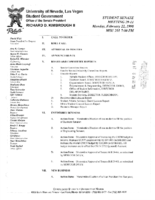
Meeting minutes for Consolidated Student Senate University of Nevada, Las Vegas, February 22, 1999
Date
Archival Collection
Description
Text
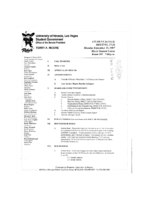
Meeting minutes for Consolidated Student Senate University of Nevada, Las Vegas, September 15, 1997
Date
Archival Collection
Description
Text
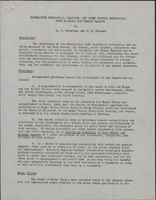
Report on cooperative irrigation, drainage, and water control educational work in Moapa and Virgin Valleys, October 10, 1945
Date
Archival Collection
Description
Discussion of the necessity of public education in the Moapa and Virgin valleys in regards to irrigation, drainage, water storage, domestic water, and flood control. Report was written October 10, 1945, attached application was dated February 3, 1945.
Text

Andres Dominguez oral history interview: transcript
Date
Archival Collection
Description
Oral history interview with Andres Dominguez conducted by Marcela Rodriguez Campo, Laurents Bañuelos-Benitez, and Barbara Tabach on February 11, 2019 for the Latinx Voices of Southern Nevada Oral History Project. In this interview, Dominguez discusses his upbringing in Las Vegas, Nevada and growing up on the Eastside. He talks about the history of barbering in his family, and his path to becoming a barber. Dominguez describes the process of acquiring the barbershop at the El Cortez Hotel and Casino, and the significance of the location to his family. Lastly, Dominguez discusses his perspective on life, the importance of networking, and his decision in naming his shop Speakeasy Barbershop LV.
Text

Peter Guzman interview, September 10, 2018: transcript
Date
Archival Collection
Description
Interviewed by Claytee White. Born in Florida, family arrived in Las Vegas in 1969. Father worked in the service industry. Worked as realtor before becoming President of the Latin Chamber of Commerce. Vice chairman of Hope for Prisoners and Vice Chairman of Workforce Connection.
Text
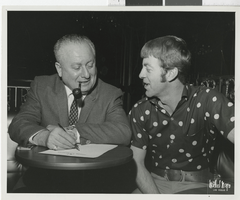
Photograph of Harold Minsky and Jerry Norman, Las Vegas (Nev.), 1970-1979
Date
Archival Collection
Description
Image

